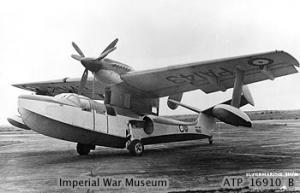Supermarine Seagull ASR-1 Video - Picture

|
|
Supermarine Seagull
Type 381 Seagull ASR-1

Picture - The first Seagull prototype, PA143 (1948)
Role: Air-sea rescue amphibian
Manufacturer: Supermarine
First flight: 14 July 1948
Retired: 1952
Status: Prototypes only
Primary user: Royal Navy
Number built: 2 (plus 1 uncompleted)
The Supermarine Seagull ASR-1 was a British military flying boat and the last to be built by the Supermarine company. Design started during the Second World War but it did not fly until three years after the war had ended and the project was cancelled without it being adopted for service.
History
In October 1940, the British Air Ministry issued Specification S.12/40 to Supermarine and Fairey for a catapult-launched, amphibian, reconnaissance and spotter aircraft to replace the Supermarine Walrus and Supermarine Sea Otter. An order for three prototypes of Supermarine's aircraft was issued in April 1943.
There was an interruption in design due to the necessity of moving the Supermarine design office, after the bombing of the facility at Woolston. Further delays were caused by the extensive wind tunnel testing that was needed and the change from a Rolls-Royce Merlin to the more powerful Rolls-Royce Griffon. Also, the design specification was changed in 1944 to a new requirement, S.14/44 (later S.14/44/2) - the role of the aircraft being changed from reconnaissance and gunnery spotting to Air-sea rescue. This change removed the four-gun turret the design had featured.
The first prototype - Seagull serial PA143 - first took off on 14 July, 1948 from Southampton Water, flown by test pilot Mike Lithgow. The second aircraft - PA147 - flew in September 1949, and was used for carrier trials on HMS Ark Royal later in that year, during which it demonstrated the capability to carry five passengers. Experiments were also carried out with rocket assisted take-offs.
By the early 1950s, helicopters were taking over the air-sea rescue role. In 1952, the two completed prototypes and the partially-built third aircraft, PA152, were scrapped.
Construction
The Seagull had an all-metal construction with a two spar parasol wing mounted on a pylon connecting it to the fuselage. The single engine, a Rolls-Royce Griffon drove contra-rotating propellers; radiators were mounted below the engine in the pylon. The rear of the pylon accommodated an observer's position with two windows. An eye bolt was fitted on the wing, behind the engine, so the aircraft could be easily lifted from the water by crane.
The wings were fitted with slotted flaps and full length leading edge slats and could be folded for compact, ship-board stowage. They also had a variable angle of incidence, pivoting at the front spar and actuated by an electrically driven jackscrew attached to the rear spar. This arrangement reduced stalling speed and increased lift, allowing the aircraft to use a smaller wing - compactness being an important feature for a ship-borne aircraft.
Supermarine had tested this arrangement in the Type 322 and its capability was demonstrated when test pilot Mike Lithgow flew a Seagull at only 35 miles per hour (56 km/h). In July 1950, a Seagull competing in the Air League Cup Race gained the air-speed record for amphibian aircraft over a 100-kilometre (62 mi) course, by flying at an average speed of 241.9 miles per hour (389.3 km/h).
The hull was a normal frame and longeron design with chines. The tailplane, carried on top of the fin, had a very large dihedral, with smaller fins mounted on its tips perpendicular to its surface. A third fin was later added to the centre after testing of the first prototype had revealed an instability in yaw. This was added to the second prototype while it was still being constructed.
The undercarriage retracted into bays on either side of the fuselage and could be easily removed, saving 180 kilograms (400 lb) of weight when the aircraft was operating as a pure flying-boat. The Seagull was also fitted with an arrestor hook for carrier landings; mounting points for JATO rockets were located just above the wheel wells.
The crew normally consisted of three. During air-sea rescue work, a Seagull would be able to accommodate a pilot, navigator and medic, plus up to seven survivors.
Operators
United Kingdom
Royal Navy
Specifications (Seagull ASR Mk.1)
(Performance estimated for 2,500 hp Griffon RG30SM)
Data from Dumbo and Seagull
General characteristics
Crew: 3
Capacity: up to seven survivors (2 on bunks, one seated and four on "emergency stations" on floor)
Length: 44 ft 1½ in (13.46 m)
Wingspan: 52 ft 6 in (16.0 m)
Height: 15 ft 10½ in (4.84 m)
Wing area: 432 ft² (40.13 m²)
Empty weight: 10,510 lb (4,770 kg)
Loaded weight: 14,500 lb (6,587 kg)
Powerplant: 1x— Rolls-Royce Griffon 29 inline piston engine, 1,815 hp (1,353 kW)
Propellers: 2 Rotol contra-rotating three-bladed propellors
Span with wings folded: 23 ft 6 in (7.17 m)
Performance
Maximum speed: 260 mph (226 knots, 418 km/h) at 11,800 ft (3,599 m)
Cruise speed: 131 mph (114 knots, 211 km/h) max range cruise
Range: 875 mi (761 nmi, 1,408 km)
Service ceiling: 23,900 ft (7,290 m)
Rate of climb: 1,515 ft/min (7.7 m/s) at 7,000 ft (2,133 m)
Bibliography
Andrews, C.F. and Morgan, E.B. Supermarine Aircraft Since 1914. London: Putnam Books Ltd.,2nd revised edition 2003. ISBN 0-851-77800-3.
Burnett, Charles and Eric B. Morgan. "Dumbo and Seagull:Two Pairs of Variable Incidence Prototypes". Air International, November 1982, Vol. 23 No, 5. ISSN 0306-5634. pp. 237-243, 251.
Kightly, James and Wallsgrove, Roger. Supermarine Walrus & Stranraer. Sandomierz, Poland/Redbourn, UK: Mushroom Model Publications, 2004. ISBN 83-917178-9-5.
London, Peter. British Flying Boats. Sutton Publishers Ltd. 2003. ISBN 0-7509-2695-3
Living Warbirds: The best warbirds DVD series.
Source: WikiPedia